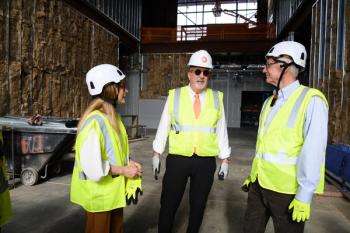
Increase your veterinary practice's reach with satellites
Secondary sites allow you to expand while still keeping overhead low.
Despite the grand plans of those in charge of stimulating us back to prosperity, the economy is still struggling. Like a salmon making its way upstream against all odds, the goal is in sight — provided you can look forward a dozen years. You may recall my projection made in this column in 1997 that the poopoo would hit the fan by 2008 and that we would spend 15 years in economic mayhem.
Everyone was excited by April's report of a 3.6 percent surge in consumer spending. It was the strongest increase in spending in the last three years but fell short of what's needed. What most people don't realize is that to get out of this recession — the longest since the 1930s — we need prolonged spending increases of 7 percent to 9 percent for at least five quarters. A 3 percent rise just maintains the abysmal status quo, compensating for population growth but creating no new jobs. We are stuck at 9.7 percent unemployment, and many of our clients are afraid to spend any more money than necessary.
The economist's math is simple. A 3 percent increase in spending keeps unemployment from rising. To decrease unemployment by 1 percent, we need an additional 2 percent increase in consumer spending. A 9 percent increase in spending gets unemployment back to a more normal 7 percent. We can live with that; we can live well with that. So if each of us increases our spending 3 percent to 9 percent more, the economy will stabilize. Oh, did I mention that these numbers are only valid if we don't lose it all to tax increases?
So, let's get real. Our only hope is to do more with less. That's what America has always done in times of stress. We tighten up our staff. At this point, most of the practices that can still pay their bills are already at a 1.6-staff-member-per-doctor ratio. And we negotiate prices with vendors, so we can sell at standard fees but pocket more. That increases productivity but puts more and more of the burden on remaining staff members.
It's likely that it will be 10 or more years before we get back to pre-2007 economic levels. The question now is, "Where do we go from here?"
The satellite solution
Despite the economy, veterinary medicine is chock full of opportunities for those who can be creative. One of the best solutions for veterinarians who are highly invested in large facilities with major overhead is to create outlying satellite clinics. Veterinarians at these smaller clinics — no more than 20 minutes from the main hospital — vaccinate and treat routine maladies. Patients are funneled from the satellite clinics to the main hospital for major diagnostic and surgical needs.
Satellite clinics blunt a rival opening a full hospital in a desirable neighborhood — generally a better economic area than the main hospital. And with satellite clinics, you are perfectly positioned for expansion when better times return. One of the major veterinary facilities in the country started as an expandable four-doctor facility with four satellite clinics.
Minimum overhead
The secret to success at the satellites is to fight the temptation to build up equipment and staff and increase your overhead. A staff of one veterinarian, one technician and one receptionist/technician in 500 to 700 square feet is the most productive formula.
One or two exam rooms with an otoscope and ophthalmoscope will suffice. Necessary lab equipment includes a microhematocrit centrifuge and glucose, BUN and urine test strips. All other lab work should be sent out. You'll also need a stainless-steel prep table that can double for a minor surgery table as well as a couple of surgical packs, injectable anesthetics and a backup oxygen tank. The autoclave remains in the main hospital. Of course, your state may have particular requirements. But because your pets won't be staying at the satellite overnight, the zoning is usually much less restrictive.
A centralized hospital
The main hospital is the crucial component. Any surgical patient that cannot be treated with the satellite's modest accommodations is driven to the main hospital at noon and returned to the satellite clinic for discharge the next day. Serious cases are admitted to the main hospital and discharged from there as well. Because satellite clinics should have fixed hours, emergencies are also seen at the main facility. Calls are forwarded to the main hospital after hours and whenever the receptionist is unavailable.
All purchasing is done at the main hospital and sold at cost to the satellite as needed. Computer bases should be Internet linked, but fee codes should be individual to each satellite. Satellite clinics often support a higher fee structure than the main hospital. Fee schedules for any one-to-five-mile radius in America are available.
Using a single name — such as Quality Care Pet Hospital Group of Your Town or Your Name Pet Hospital (A Quality Care Pet Hospital) — will unify the satellite clinics and main hospital in clients' minds.
Mergers
Human medicine already follows the satellite model. Taking it a step further, however, some small human hospitals merge to form more cost-effective major hospitals.
There are many towns with three veterinary hospitals all just managing to scrape out a living. A single merged facility would be more efficient and more profitable for all. The only thing preventing this sensible move is ego. It is the old story of two veterinarians cast ashore on a deserted island where three hospitals are built: mine, yours and a third that neither of us would be caught dead in.
Bottom line
If you have good staff and not enough clients to keep them busy, you can keep them and still expand productivity by either separating with satellite clinics or merging with other practice owners in your situation.
Whether you're in an economically weak or strong area, in my experience both concepts work. Practices in better areas benefit from owners tightening their management policies, and that may be a necessity in harder-hit places.
Dr. Snyder, a well-known consultant, publishes the newsletter Veterinary Productivity. He can be reached at 112 Harmon Cove Towers Secaucus, NJ 07094; (800) 292-7995;
Newsletter
From exam room tips to practice management insights, get trusted veterinary news delivered straight to your inbox—subscribe to dvm360.




